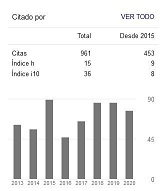Technical Efficiency of Artificial Insemination in Dairy Cattle Companies in Camagüey, Cuba.
Resumen
The technical efficiency behavior of artificial insemination in dairy cattle companies in the province of Camaguey, Cuba, was assessed. The breeding data (January 2009-December 2005) from the livestock Vice Presidency of the Ministry of Agriculture in the province were used in the study. The technical efficiency of insemination was calculated from the total number of inseminated females that tested positive to pregnancy diagnostic in every month and company. Range graphic and frequency analyses were performed, and the series components were determinedby the multiplicative method. Autocorrelation analysis and seasonal decomposition were made, considering ± 10% as seasonability criterion. The technical efficiency values observed for artificial insemination ranged between 40 and 64%, with a mean of 51.49%. The most commonly observed frequencies were between 48 and 56%, with a stable behavior, and seasonal indexes between 90.21 (May), to 108.91 (September). The decrease in the mean values of technical efficiency in artificial insemination was characterized by the lack of seasonal behavior. It indicated the need to evaluate other factors related to the technical work, as well as other organizational aspects of breeding linked to measures implemented by management in 2008.
Descargas
Citas
BANE. A y HULTNÄS, C. A. (2008). Artificial Insemination of Cattle in Developing Countries. Roma, Italy: FAO Corporate Document Repository.
BERTOT, J A.; VÁZQUEZ, R.; AVILÉS, R.; DE ARMAS, R.; GARAY, MAGALY; LOYOLA, C. y HORRACH, M. (2006). Análisis del comportamiento estacional y tendencia de las categorías reproductivas y los nacimientos en empresas pecuarias lecheras. Rev.prod.anim., 18 (2), 149-154.
BERTOT, J A.; VÁZQUEZ, R.; DE ARMAS, R.; GARAY, MAGALY; AVILÉS, R.; TEJEDA, E.; LOYOLA, C. y HORRACH, M. (2008). Determinación de las variables más representativas para la organización y el control de la reproducción en sistemas vacunos lecheros. Rev. of Animal Production Anim., 20 (1), 65-71.
BERTOT, J. A. (2007). Modelo estructural para mejorar la organización y el control de la reproducción de sistemas vacunos lecheros. Tesis doctoral no publicada, Universidad de Camagüey, Cuba.
BOLS, P.E.J.; LANGBEEN, A.; GOOVAERTS, I.G.F. y LEROY, J.L.M.R. (2010, May). Biotechnology of Reproduction in Farm Animals with an Emphasis on Cattle Assisted Reproductive Techniques. In J. Estany, C. Nogareda and M. Rothschild, Adapting Animal Production to Changes for a Growing Human Population (pp. 45-60). International Conference, Lleida, España, 19-21.
DE JARNETTE, M. (2003). Some Things Never Change. Select Sires. Retrieved on June2, 2014, from http://www.selectsires.com/selections02.html.
MORTON, J. (2004). Determinants of Reproductive Performance of Dairy Cows in Commercial Herds in Australia. Submitted in Total Fulfillment of the Requirements of the Degree of Doctor of Philosophy, Veterinary Science, University of Melbourne.
PUPO, JUANA; GONZÁLEZ, ERMIDA; NENINGER, DORIS
y GÓMEZ, R. (2004). Análisis de regresión y series cronológicas. La Habana, Cuba: Editorial Félix Varela.
RISCO, C. y ARCHIBALD, L.(2005) Eficiencia reproductiva del ganado lechero. Producción Animal, 16 (162), 42-49.
SOTO, S.A.; CURBELO L. M.; GUEVARA, R.V.; MENA, MADELINE; DE LOYOLA, C.; UÑA IZQUIERDO, F. y ESTÉVEZ, J. (2014). Efecto de patrones de concentración de parición en el periodo abril-agosto en vaquerías comerciales. I. Eficiencia bioproductiva. Rev. of Animal Production Anim., 26 (2), 30-33.
Los autores de los artículos publicados en RPA retienen los derechos de autor de su trabajo, de marca y patente, y también sobre cualquier proceso o procedimiento descrito en el artículo, así como a compartir, copiar, distribuir, ejecutar y comunicar públicamente el artículo publicado en la RPA o cualquier parte de aquel siempre que indiquen la fuente de publicación (autores del trabajo, revista, volumen, número y fecha), pero están de acuerdo en que la revista publique los trabajos bajo una licencia Creative Commons.
![]() Licencia Attribution-NonCommercial 4.0 International (CC BY-NC 4.0)
Licencia Attribution-NonCommercial 4.0 International (CC BY-NC 4.0)






































